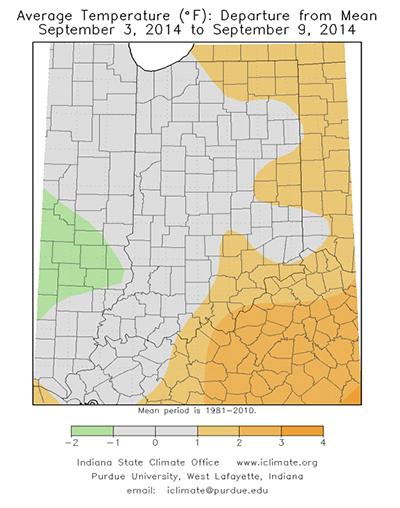USDA-NIFA Extension IPM Grant
Pest & Crop Newsletter, Entomology Extension, Purdue University
Beauties and the Beasts – (John Obermeyer and Christian Krupke) –
• Caterpillars that may have fed on crops are now gracing the roadsides with pretty butterflies
• Three species described below
While driving through the countryside, many have been greeted with the pleasing sight of several colorful butterfly species on and along side of roads, near puddles of water, or on flowering plants. Ironically, these beauties originated from larvae that may have fed on soybean or alfalfa. However, it is rare for any of these species to cause significant yield losses from defoliation. Below is a listing, with pictures, of some of the common butterflies and their caterpillars this time of year. Although you will find some of these feeding in crops, none are pests.
The painted lady butterfly, Vanessa cardui, is mostly orange mottled with black and white markings. This is a migratory species flying from and to Mexico and the Southwestern United States in the spring and fall. Adults arrive in Indiana in the spring and lay their eggs on several species of plants. Although they feed on many weed species, their preferred host is Canada thistle. Several generations occur in Indiana before they begin their migration southwestward in the fall. The larvae, known as thistle caterpillars, are generally dark in color, with conspicuous yellowish markings on their bodies. The larvae are covered with many branching spines. Larvae reach a length of about 1-1/4 inches. The larvae feed within webbed enclosures on the upper leaves and may defoliate entire patches of weeds and feed in a similar manner on soybean.
Painted lady butterfly
Thistle caterpillar within its webbing
The yellow, alfalfa butterfly, Colias eurytheme, is a member of the “sulfurs.” These butterflies congregate in large numbers near sources of moisture. They are most active during mid-day, their peak mating time. The larvae of these butterflies are the alfalfa caterpillar. This caterpillar is up to 1-1/2 inches long, has a velvety-smooth lime-green body with a white stripe on each of its sides. This caterpillar is common in alfalfa, clover, and vetch, but it can be occasionally found defoliating soybean leaves. Though the numbers of butterflies may be numerous, this does not indicate an outbreak of caterpillars is soon to follow. These caterpillars are very susceptible to insect diseases that can rapidly bring their numbers down to very low levels.
Alfalfa butterfly on velveleaf
Thistle caterpillar within its webbing
The creepy looking caterpillar award goes to the silver-spotted skipper, Epargyreus clarus. These larvae are up to 2 inches in length, have brownish-red heads with two orange spots and a yellowish-green body. Larvae can often be found in leaves that have been rolled together and held by the caterpillars’ silken threads. Feeding damage is generally localized to a few surrounding plants. Adult skippers, which are commonly seen feeding on flowers late in the summer, have an obvious silver-white splotch on each wing.
Larva of the silver-spotted skipper
![]()
Fall Armyworm Outbreaks Reported – (John Obermeyer)
Doug Johnson, University of Kentucky Extension Entomologist, has recently reported in their Pest News of large populations of fall armyworm (FAW) moth captures and now caterpillar infestations. Just in the last couple days, we have received calls from west central and north western Indiana of “worms” devouring forage crops. From their description of the caterpillars and damage of the various crops, it is likely FAW. Just like a very similar species, the armyworm, the behavior is much the same in that they can consume large amounts of foliage as they move enmasse.
Those with late season crops should be inspecting for feeding damage. This is very important for newly seeded forages. Below is listing of high-risk situations, put together by our colleagues Doug Johnson and Patty Lucas at the University of Kentucky:
“So, what is likely to be at risk? In order of damage potential:
• Newly seeded grasses of any kind, including but not limited to, the following: grass (wheat & rye) cover crops, grass and mixed grass / alfalfa hay fields, and early planted wheat.
• Established mixed grass and alfalfa hay, grass forages, lawns, parks and playing fields, etc. This insect really likes Bermuda grass, but fescue can also be hammered, and it has a difficult time recovering in hot dry weather.
• Possibly very late double crops beans. Soybean is not a preferred food, but FAW will feed on them. The most likely places and the first to be noticed are field edges and waterways of grass, as well as interior of soybean fields that have a significant grass weed population. If the caterpillars are already feeding on grass weeds within a field and the weeds are killed, the caterpillars will move to the beans. Palatable or not, these insects will try to eat anything to stay alive!
• Full season corn, grain sorghum, and soybeans are probably too mature to be damaged much.”
FAW caterpillars are feeding on alfalfa (Photo credit: Dave Duttlinger)
Field of alfalfa with severe FAW damage (Photo credit: Dave Duttlinger
FAW denuded alfalfa plants (Photo credit: Dave Duttlinger
![]()
Waterhemp Plant Tissue (or Seed) Samples For Screening Resistance to PPO Herbicides (pdf)
![]()












